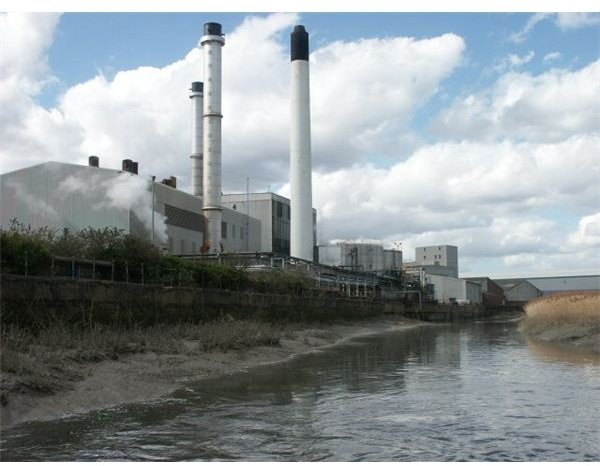An Analysis: What Do Industrial Architects Do?
The architecture of commercial and public buildings remained indistinguishable from domestic houses in the pre-Industrial Revolution era. The only differentiator was size, with buildings that served the needs of commerce and industry bigger in size to accommodate more people than dwelling houses could.
With the industrial revolution heralding machines and mass production, commercial and industrial establishments began to depend more on machines and processes, and soon commercial spaces such as stores, banks, factories, warehouses, and other places began to take a distinct structure, feature, and layout to accommodate such machinery and processes. Industrial Architecture is the branch of architecture that caters to such distinct buildings that meet the needs of commerce and industry, and industrial architects apply their knowledge of architecture to design and create such spaces.
Image Credit: geograph.org.uk/Martin Wilson
Job Profile
What do Industrial Architects do?
Industrial architects design:
- places of commercial exchanges such as office buildings stores, markets, banks, warehouses, and exhibition halls;
- transportation infrastructure such as bridges, tunnels, railway stations, seaports, airports, garages, fuel stations, and hangars;
- communication infrastructure;
- manufacturing centers such as factories, mines, laboratories, and food-processing plants;
- power installations such as dams, generating plants, fuel storage, processing, and distribution installations;
- press and media centers; and
- other commercial facilities.
Industrial Architects develop plans, communicate such plans to contractors, and ensure implementation of plans by supervising the actual construction. The industrial or business architect job description includes organizing, planning, and assigning jobs, writing and reviewing specifications, preparing and maintaining schedules, developing and monitoring estimates and forecasts, and more.
Planning
Planning ranks amongst the primary activity of any architect.
When planning for commercial and industrial projects, industrial architects consider economic aspects such as optimizing the returns for the investment of land, materials, and labor in the project. For instance, when land value is high and space limited, industrial architects try to design in height, whereas when land is aplenty, such as construction in the middle of a desert, the architect designs for breath and depth.
Another dimension of planning entails controlling the effects of natural forces such as heat, cold, light, air, sound, and moisture, based on the purpose of construction. For instance, a semiconductor-manufacturing plant requires incorporation of airtight windows and good temperature and humidity control mechanisms into the design. The design of a laboratory might require thick walls with insulating materials in between the walls or adjusting the height of the ceiling to preserve heat. The design of an airport might require due considerations to acoustics to ensure effectiveness of the public announcement system.
Layout
A major distinguishing factor in the job profile of an industrial architect compared to a general architect is the focus on exchange of goods or people. The industrial architect ensures smooth and seamless flow of goods and people.
A good industrial architect customizes theoretical considerations with actual needs of the industry or concern and incorporates flexibility into the design, to make changes as and when required.
For instance, the industrial architects design a production plant in a way that accepting raw materials, the various processing stages, checking, packing, and distribution all take place in the fastest way with the minimal movement. The industrial architect also designs workstations to ensure that work takes place under optimal lighting, accessibility, positioning, and other ergonomic considerations.
In a retail store, the industrial architect designs the layout to ensure that goods display prominently, customers access the required goods easily, and prevent overcrowding at entrances, checkouts, and other spaces.
In an airport terminal, the industrial architect designs for a smooth flow of arrival and departure passengers, seamless and non-congested check in and baggage handling procedures, easy accessibility to and by support service, adequate car park facilities, convenient transit lounges, adequate circulating area for vehicles to drop passengers and park, and more.
Emerging Trends
The trend in industrial architecture is combining functionality with aesthetics. Industrial and commercial complexes of today stand out for their appearance and harmony with the surrounding environment. Eco-friendly initiatives such as incorporating green building technology, renewable energy concepts, designing LEED-certified spaces, ensuring carbon neutrality, and similar considerations have become an important part of the industrial architect’s job profile.
The increased importance to aesthethics also makes landscaping architecture a major part of the industrial architect’s job profile.
The industrial architect harmonizes the facility to the demands of environment, utility, and economy, thereby providing a cultural and utilitarian value apart from functional value.
References
- Encyclopedia Britannica “Architecture” https://www.britannica.com/EBchecked/topic/32876/architecture/31812/Commercial-and-industrial-architecture?anchor=ref405522. Retrieved 31 December 2010
- Bureau of Labor Statistics. Occupational Outlook Handbook 2010-11. “Architects, Except Landscape and Naval.” https://www.bls.gov/oco/ocos038.htm. Retrieved 31 December 2010
